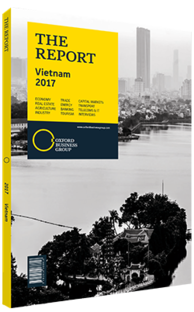Vietnam's government works to improve state's balance sheet
Rising public debt and persistent budget deficits are among the greatest downside risks to what is otherwise a generally robust economic outlook for Vietnam. According to official figures, public debt came in at 64.73% of GDP in 2016, just below the 65% ceiling set by the National Assembly, despite government revenues coming in 7.8% above target. With this in mind the government’s budget and financial plans for 2016-20 have been revised to agree with Decision No.25 2016/QH14 issued in November 2016.
The decision states that the state budget deficit ratio during the 2016-20 period should be less than 3.9% of GDP, and the government will try to reduce the deficit to less than 3.5% of GDP by 2020. Annual national debt is expected to be less than 65% of GDP, while government debt should not exceed 54% of GDP and national foreign debt should not be higher than 50% of GDP. In addition, national foreign debt should not rise above 25% of total exports and direct government debt, excluding on-lending, should be less than 25% of total annual state revenue.
Deficits have averaged 6.5% of GDP since 2012, according to the IMF, which expects fiscal gaps of 6.5% in 2016 and 6% in 2017. The deficit has been driven by several factors, including tax and tariff cuts, lower government oil revenues, higher interest payments and higher current expenditure. Government revenues fell from 25% to 20% of GDP between 2009 and 2014, according to the World Bank.
Rising Pressures
The IMF estimates that these factors led to Vietnam’s debt rising 16 percentage points in the five years to 2016, and its baseline scenario is that debt will reach 70% of GDP in the medium term, with the deficit averaging 5% over the coming years. A flexible fiscal policy was implemented after the 2008 global economic crisis, with the stimulus taking up the slack at a period of lower investment. However, the economy has achieved over 6% growth three years in a row, and private consumption and investment are stronger. With downside risks to the global economic outlook looming, the pressure for the government to tighten its fiscal stance is rising, as Vietnam could shift into a pro-cyclical fiscal policy – continuing to run high deficits when the economy is performing strongly, and then being forced to raise taxes and cut expenditure in a sharp slowdown to prevent the deficit and debt from ballooning.
Furthermore, the rising burden has increased the proportion of GDP that must be spent servicing debt, using resources that could be allocated to other investments. Vietnam is also likely to start paying more for international financing, as the grants and low- or zero-interest development assistance that was once available to the country, due to its low-income status, begins to taper down. “Debt is a vulnerability, and projections too often assume that FDI will continue at current levels in a linear extrapolation,” Anirban Lahiri, senior research manager at Viet Capital Securities, an investment banking firm, told OBG. “But there are risks building. The good news is that Vietnam has little external debt – a bit in dollars, euros and yen, but a fraction of the total. Most government debt held is domestically.”
Government Plans
While a fiscal cliff-edge seems unlikely, reducing the deficit and curtailing debt growth have become priorities. The government has pledged to reduce the deficit to an average of 4% in the 2016-20 period, reducing it to around 3% by 2020, and staying under the legal 65% debt limit. In June 2016 Prime Minister Nguyen Xuan Phuc asked ministries to move towards balanced budgets. A government directive focusing on the Ministry of Finance required it to ensure that revenue collection met targets, to tackle tax evasion and enhance tax collection. Provincial governments were also asked to boost revenue-gathering. Over the medium term, the ministry is also required to assess the impact of free trade agreements on government revenues.
You have reached the limit of premium articles you can view for free.
Choose from the options below to purchase print or digital editions of our Reports. You can also purchase a website subscription giving you unlimited access to all of our Reports online for 12 months.
If you have already purchased this Report or have a website subscription, please login to continue.

